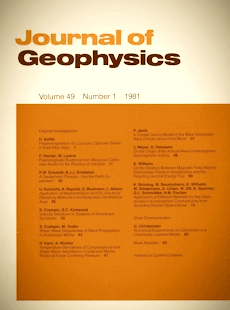Steady state creep of fine grain granite at partial melting
Article Sidebar

Vols. 1-18 (1924-1944), ISSN 0044-2801
Main Article Content
Abstract
Steady state creep under constant stress has been measured in a fine grain granite (aplite) from Schauinsland, Germany for the temperature range of partial melting 860°–1060°C, under a hydrostatic pressure of 4.2 kbar, and at low shear stresses of 5–50 bar. The apparatus used is described briefly. Rheological measurements are complemented by microscopic investigations. With a melt fraction of up to about 20%, creep can be described by a power law with a stress exponent of 3-4 and an activation energy of 80 kcal/mole, typical for creep in solids. Above 1010°C or 20% melt, the activation energy increases rapidly to a value of 200 kcal/mole simultaneously with a rapid increase of the melt fraction and a decrease of feldspar content. From the grain structure and from etching tests it is concluded that quartz contributes little to the plastic deformation which is governed mainly by the stress and temperature induced recrystallization of feldspar. The large temperature dependence of the creep rate above 1010° C may be caused by the decreasing area of grain contacts and consequent rise in local stress. These results support those of Arzi (1974) and Roscoe (1952).
 ARK: https://n2t.net/ark:/88439/y060550
ARK: https://n2t.net/ark:/88439/y060550
Permalink: https://geophysicsjournal.com/article/258
Article Details
References
Arzi, A. (1978) Critical phenomena in the rheology of partially melted rocks. Tectonophysics 44:173-184
Berckhemer, H., Auer, F., Drisler, J. (1979) High temperature anelasticity and elasticity of mantle peridotite. Phys. Earth Planet. Inter. 20:48-59
Carter, N. (1976) Steady state flow of rocks. Rev. Geophys. Space Phys. 14:301-360
Goetze, C. (1977) A brief summary of our present day understanding of the effect of volatiles and partial melt on the mechanical properties of the upper mantle. In: Manghnani, M.H., Akimoto, S.I. (Eds.) High pressure research, pp. 3-24. New York, Academic Press
Molen, I. Van der, Paterson, M.S. (1979) Experimental deformation of partially melted granite. Contrib. Mineral. Petrol. 70:299-318
Paterson, M.S. (1979) The mechanical behaviour of rock under crustal and mantle conditions. In: McElhinny, M.W. (Ed.) The Earth, its origin, structure and evolution. Academic Press, New York
Press, F. (1959) Some implications of mantle and crustal structure from G waves and Love waves. J. Geophys. Res. 64:565-568
Ringwood, A.E. (1969) Composition and evolution of the upper mantle. In: Hart, P.J. (Ed.) The Earth's Crust and Upper Mantle, Geophys. Monogr. 13:1-17. Am. Geophys. Union, Wash. D.C.
Ritsema, A.R. (1972) Synopsis of some comments on Sir Herold Jeffrey's paper on creep in the Earth and planets. Tectonophysics 13:579-580
Roscoe, R. (1952) The viscosity of suspension of rigid spheres. Br. J. Appl. Phys. 3:267-269
Weertman, I., Weertman, I.R. (1975) High temperature creep of rock and mantle viscosity. Annu. Rev. Earth Planet. Sci. 3:293











